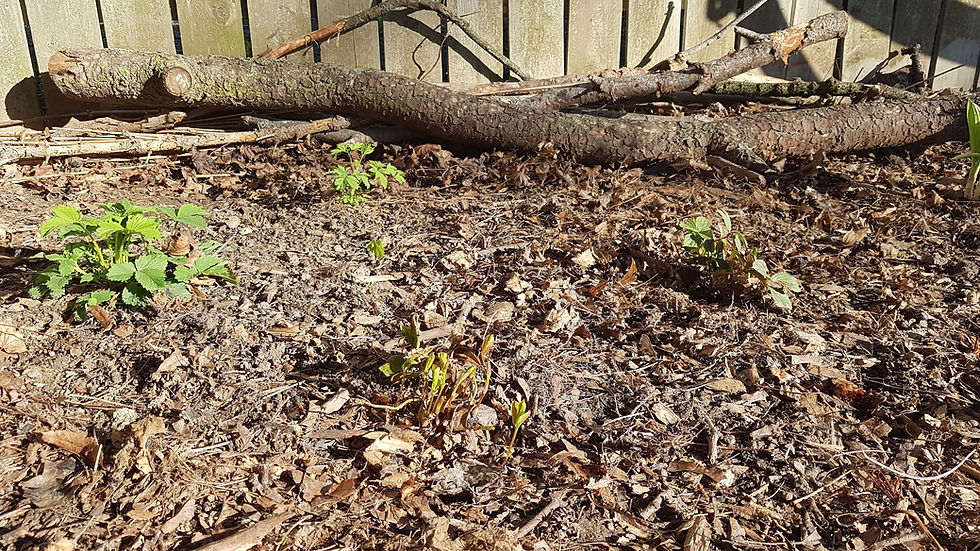Radiating Beauty: the Staghorn Sumac
- Jeanne McRight

- Jan 15, 2022
- 3 min read
Updated: Jan 17, 2022
by Mohan Iyer, Mississauga Master Gardener
Looking for an easy-care small native tree that is gorgeous in every season, beloved by pollinators and birds, and can replace invasives like burning bush, alpine current and Tatarian honeysuckle? Then look no farther - staghorn sumac fits the bill!
Rhus typhina, the staghorn sumac, is a large deciduous shrub or a small tree with crooked trunks and branches and velvety twigs that resemble the antlers of a stag. It's native to the eastern United States, southern Ontario and east into Quebec. Smooth sumac, R. glabra, is very similar.

The winter beauty of a staghorn sumac colony.
Identification: The leaves of this plant are 5-12 cm long with 11-31 leaves per leaflet. They are lance shaped, sharp toothed with fine hairs located on the veins. It can grow up to 6 m high, 10 cm in diameter and live for 50 years. The bark is thin and nearly smooth, but sometimes peels off in layers. Small, yellow-green flowers form in dense clusters that stand up at the ends of the twigs and typically bloom in June or July. Depending on the tree, it could produce all male flowers, all female flowers, or all perfect flowers meaning that each flower has both male and female flower parts. The fruit ripens and hardens in late summer, turning a scarlet red when ripe. Fruits of the staghorn sumac are 3-5 mm across and red and juicy when mature. They are covered with glandular reddish hairs and are located in large cone shaped clusters at the tips of the twigs.
Spring, summer, fall and winter - staghorn sumac is glorious throughout the year.
Habitat: The staghorn sumac is very hardy and generally grows in open places such as roadsides, forest edges and clearings. It likes lots of sun and tolerates most soil types, including poor dry areas. This species is very pest and disease resistant. In sweeping southern Ontario landscapes it's often seen in colonies on slopes, with the tallest mature trees in the center and the smaller young trees radiating outward. The masses of textured foliage create a beautiful flowing form. But staghorn sumac is just as happy in urban settings, and looks wonderful by itself tucked into gardens both small and large.
Cultivation: Staghorn sumacs are easy to grow in most soils if planted on a site with good drainage and full sun. They are hardy to Zone 4, drought and salt tolerant and deer resistant. It is a good erosion control plant as it spreads by root suckers forming colonies and thickets. You can control its spread by planting the tree close to a paved or mowed area.
Use: The bark and berries of both staghorn and smooth sumac have been much used in tanning and dyeing, and the bark and berries often used in herbal medicine for their astringent qualities (similar uses in both European and Indian cultures). The berries make a delicious cold tea, and can be used to flavour meats.
Value for wildlife: In summer, look for the many native bee species, honey bees and several butterfly species which are highly attracted to the staghorn sumac's nectar rich flowers, plus their caterpillars which forage on the leaves. Some small carpenter bee species will create nesting chambers in sumac twigs.

Iridescent green sweet bee sipping nectar from a staghorn sumac blossom. Photo by Carol Pope Gordon.
Over 300 species of birds are known to feed on sumac fruit including ruffed grouse, wild turkey, American robin and other thrush species, chickadee, gray catbird, northern cardinal and most woodpecker species. They are an invaluable emergency source of food in winter as the berries hang on to the plant through the colder months.

Ruby-crowned kinglet perched on a staghorn sumac twig. Photo ©2021 Peeter Poldre.
If you're looking for a small tree for your garden that provides year long interest, blazing red fall colors and significant value for wildlife and pollinators, the staghorn sumac should be at the top of your list.
References:

















Comments